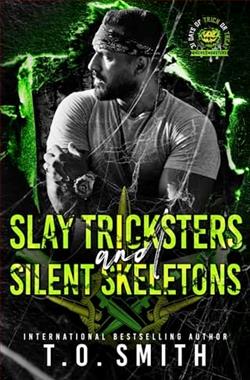Page 26 of The Texas Murders
She explains that she didn’t find anyone who remembered seeing a vehicle that fit the description. However, she had already obtained security camera footage from the Speaking Rock casino on the day Marta went missing. One outdoor camera has a good view of one of the main roads through the Pueblo.
The footage has been saved onto a DVD, and Ava picks up a remote and turns on the TV. She plays a few seconds showing cars going up and down the roadway.
“That’s the way we came in today,” I say.
“There,” Ava says, pausing the screen.
The image is grainy, but a van is definitely visible, and it seems to have the same color as Llewellyn Carpenter’s vehicle.
“Looks like the one,” I say.
We’re all quiet for a moment as it sinks in what this might mean.
“The good news,” Carlos says to Ava, “is that the FBI knows who that guy is and they’re taking steps to rescue at least some of the women he’s abducted.”
“Hopefully we’ll be able to find Marta Rivera and bring her home,” I say.
Ava looks dubious.
“You said that was the good news,” she says to Carlos. “Does that mean there’s bad news?”
Carlos nods. I already know what he’s going to say.
“The bad news is that I think our eagle feather victims are a different case entirely. I don’t think either Fiona Martinez or Rebecca Trujillo will turn up when the feds conduct their raid. And,” he adds, “I wonder if there might be more eagle feather victims we don’t know about yet.”
CHAPTER 20
AVA MAKES ROOM for Carlos and me in the tight investigation room, clearing space on the table. Carlos and I bring in our laptops and the three of us get to work, hunting through the FBI database and making phone calls. Carlos orders food—another pizza—and we eat lunch while we work.
Given our new access to FBI online tools, it doesn’t take long to discover that two years ago, on the solstice, a Ute woman from Durango, Colorado, disappeared and was never found. A year before that, a Kickapoo woman from Houston disappeared.
Also on the solstice.
Also never found.
It takes us longer to figure out if golden eagle feathers had been left behind. I call the Durango Police Department and finally convince someone to look through the old files. There are no feathers in evidence, but the officer I speak with flipsthrough some crime scene photos and sees a feather on a desk in the woman’s room. He takes a picture of the picture and texts it to me. The image isn’t great, but the size and color of the feather show that it, too, probably belonged to a golden eagle.
Meanwhile, Ava calls the Houston Police Department, and after some digging, they find a feather in an old evidence box. By midafternoon, we’ve established that for four years in a row, Native women went missing on the solstice, with feathers left behind. In all cases the women were young, between eighteen and twenty-one. We can’t yet see any other links between them.
They come from four different tribes—Tigua, Navajo, Kickapoo, and Ute—and it’s doubtful any of the women knew each other. Even though the last two—Fiona Martinez and Rebecca Trujillo—both disappeared from the El Paso area, Fiona was actually from Flagstaff, Arizona, and had only recently moved to Texas. Rebecca was already gone by then.
While Carlos continues typing away on his laptop, Ava and I begin discussing what it’s going to take to fully look into these four missing persons cases. We’ll need access to all four police files. We will need to travel to these different communities, spanning four states, and interview the women’s friends and family members. We’ll need to examine whatever evidence the local authorities have in storage.
The bottom line: We’re going to need a bigger team than the three of us.
“I think it’s time we let Ryan Logan know what we’ve found,” I say. “We’re going to need help.”
“Wait one second,” Carlos says, still scrutinizing hiscomputer screen. Finally, he looks up with a satisfied expression and says, “I think I found a fifth victim.”
He explains that four years ago on the solstice, a young woman went missing. She was seventeen, which makes her a little younger than the others. Nothing in the record says anything about an eagle feather, but the disappearance on the solstice is significant.
“Where was she from?” Ava asks.
“Right here on the Tigua Pueblo,” Carlos says. “She was last seen at a powwow happening in El Paso, so the local cops and the feds took the lead in the investigation.”
“I wasn’t here that far back,” Ava says. “I was working for the highway patrol up in the Panhandle.”
“There’s more,” Carlos adds, grinning because he knows that he’s holding us in suspense.















